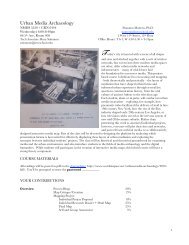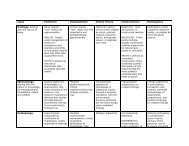Language Thought Culture - Words in Space
Language Thought Culture - Words in Space
Language Thought Culture - Words in Space
Create successful ePaper yourself
Turn your PDF publications into a flip-book with our unique Google optimized e-Paper software.
<strong>Language</strong>, <strong>Thought</strong> & <strong>Culture</strong><br />
E59.0010003<br />
MW 9:30-10:45am Ma<strong>in</strong> 407<br />
Shannon Mattern<br />
Ph.D. Candidate, Department of <strong>Culture</strong> & Communication<br />
SMatt31171@aol.com<br />
(212) 9897976<br />
When and Where You Can F<strong>in</strong>d Me:<br />
M 11:00-12:00 Department Office, 7 th Floor East Build<strong>in</strong>g<br />
W 11:00-11:45 Department Office, 7 th Floor East Build<strong>in</strong>g<br />
R 1:00-3:00 Barney Build<strong>in</strong>g #505 (notification<br />
requested)<br />
Other times by appo<strong>in</strong>tment<br />
Why We’re Here:<br />
Dur<strong>in</strong>g this course we will exam<strong>in</strong>e language and culture as means of communication, as<br />
social processes, and as representations of m<strong>in</strong>d. Dur<strong>in</strong>g the semester, we’ll (1) analyze<br />
language as the primary symbolic medium through which humans record, represent, and<br />
understand their experiences; (2) exam<strong>in</strong>e culture as a complex system of symbolic<br />
<strong>in</strong>teractions; and (3) discover relationships among language acts, people’s m<strong>in</strong>ds, social<br />
contexts, and cultural mean<strong>in</strong>gs. In addition, we’ll come to appreciate language as a<br />
powerful tool with which we can sharpen our critical read<strong>in</strong>g, writ<strong>in</strong>g, and reason<strong>in</strong>g skills.<br />
What We Hope to Accomplish:<br />
• To simulate th<strong>in</strong>k<strong>in</strong>g about and build knowledge of how language as a cultural<br />
medium works <strong>in</strong> human perception, understand<strong>in</strong>g, <strong>in</strong>teraction, and systems.<br />
• To consider the role that <strong>in</strong>teractive cultural contexts play <strong>in</strong> people’s use and<br />
understand<strong>in</strong>g of symbols, and thus their th<strong>in</strong>k<strong>in</strong>g and behavior.<br />
• To further develop skills <strong>in</strong> (a) analyz<strong>in</strong>g language texts, (b) written and spoken<br />
expression, (c) research and <strong>in</strong>quiry, and (d) argumentation and reason<strong>in</strong>g.<br />
Our Tools:<br />
We will make use of an “official” LTC read<strong>in</strong>g packet and a supplemental sectionspecific<br />
read<strong>in</strong>g packet, both of which you’ll f<strong>in</strong>d at Advance Copy, 552<br />
LaGuardia (South of 3 rd St.). I’ll distribute a few additional read<strong>in</strong>gs (mostly<br />
articles from the popular press) <strong>in</strong> class. I also <strong>in</strong>vite all of you to share with the<br />
class any relevant resources/materials you f<strong>in</strong>d on your own. Examples <strong>in</strong> all<br />
media are welcome.
Your Part:<br />
30% Attendance and Participation 1<br />
• Perfect attendance is, of course, ideal—but you will be permitted two<br />
absences dur<strong>in</strong>g the semester—no questions asked. The third and any<br />
subsequent absences will affect your attendance grade. Anyone<br />
absent for more than eight classes will not receive a pass<strong>in</strong>g grade.<br />
30% Three Short Papers (2-3 pages each, more details later)<br />
• Everybody’s Got Style: Stylistic Analysis<br />
• Unpack-a-Metaphor<br />
• Cultural Cartography: Mapp<strong>in</strong>g Your Local <strong>Culture</strong><br />
All papers should be typed, double-spaced, edited, proofread, and<br />
stapled.<br />
We will discuss the Punctuality Policy <strong>in</strong> class.<br />
15% Individual Paper<br />
10% Group Presentation<br />
15% F<strong>in</strong>al Exam<strong>in</strong>ation<br />
1 The participation portion of the grade is based on two criteria: (1) your attendance and<br />
effective participation <strong>in</strong> class and (2) your participation onl<strong>in</strong>e. Details about the class<br />
website will follow.<br />
By November 15, you will need to post at least ten substantial (a paragraph of four to<br />
six sentences), critical comments or questions to the Discussion Board, which you’ll f<strong>in</strong>d<br />
under the “Communication” section of the class website. These post<strong>in</strong>gs could take the<br />
form of personal anecdotes—stories expla<strong>in</strong><strong>in</strong>g how LTC concepts become real <strong>in</strong> your<br />
everyday lives—or synopses of magaz<strong>in</strong>e or newspaper articles, TV shows, or movies <strong>in</strong><br />
which you see LTC at play. Or, if you disagree with an argument presented <strong>in</strong> a particular<br />
read<strong>in</strong>g or a previous discussion, you could voice your criticism. And if you’re confused<br />
about a theory or concept, you could pose a specific question to the group.<br />
This is your site; it’s your public forum. Use it as frequently as you wish, and for whatever<br />
reasons you f<strong>in</strong>d appropriate. All I ask is that you exercise critical thought, communicate<br />
lucidly, and use the website responsibly.
F<strong>in</strong>al Project: Individual Paper and Group Presentation<br />
With<strong>in</strong> the first few weeks of class you’ll establish groups of 3-4 people to exam<strong>in</strong>e a<br />
subculture that’s unfamiliar to most members of your group. What are some examples of<br />
subcultures? Goths, the dot-com crowd, hardcore kids, senior citizen triathletes, moms who<br />
love boy bands, people who dress their pets like children, racial m<strong>in</strong>orities, etc. These and<br />
other subcultures have a “lore” that tells people, both the <strong>in</strong>-group and the out-group,<br />
what it takes to be a member. Your job is to identify, categorize, and <strong>in</strong>terpret artifacts<br />
and language that communicate someth<strong>in</strong>g about a subculture’s characteristic m<strong>in</strong>dset and<br />
behavior. You may want to address the follow<strong>in</strong>g questions:<br />
• How does this group orient itself <strong>in</strong> relation to the rest of the world? How does the<br />
group position itself <strong>in</strong> the universe, <strong>in</strong> the nation, <strong>in</strong> the community? What are their<br />
conceptions of space and time? How does it identify itself ideologically (culturally,<br />
socially, politically, economically)?<br />
• Is there a particular historical, geographical, or sociological background to the<br />
subculture?<br />
• How is membership <strong>in</strong> the subculture determ<strong>in</strong>ed or def<strong>in</strong>ed?<br />
• How do people <strong>in</strong> the group negotiate their social relationships? How do they<br />
<strong>in</strong>teract with one another and with “outsiders?” What do these patterns of<br />
behavior say about the group identity?<br />
• What special words, phrases, or l<strong>in</strong>guistic categories does the subculture use? Is<br />
this language unique to the group? What does it reflect about the subculture?<br />
• Does the group hold any particular objects <strong>in</strong> high regard? Do they make use of<br />
any particular apparel or ornamentation—or any other symbolic object(s)? What<br />
is the mean<strong>in</strong>g of these objects to the group?<br />
• Are there any unique rituals or social activities that def<strong>in</strong>e the subculture?<br />
Each member of your group will select different “symbolic items” (objects, concepts,<br />
l<strong>in</strong>guistic constructions, behaviors, etc.) to analyze. This analysis will require that you<br />
observe your subculture; take note of their language and paralanguage, their body<br />
movements and patterns of social <strong>in</strong>teraction. Speak with members of the group. I<br />
recommend that you keep a log of your research (for your own use), and update it<br />
regularly. Include bra<strong>in</strong>storms, reflections, doodles, and diagrams.<br />
Supplement your first-hand research with other sources: books, articles, movies, websites,<br />
z<strong>in</strong>es, “tokens,” and music made by/for/about your subculture; <strong>in</strong>terviews with<br />
anthropologists, sociologists, psychologists, therapists, social workers, teachers, etc.; maps<br />
of the group’s neighborhoods, territories, or hangouts….<br />
Individual Papers:<br />
Each student will compose a six- to eight-page analytic paper address<strong>in</strong>g a particular<br />
artifact (symbolic item) from with<strong>in</strong> the subculture. The paper should <strong>in</strong>volve both<br />
description and analysis of your object of study—and you should demonstrate, through<br />
your analysis, an understand<strong>in</strong>g of the <strong>in</strong>terplay between language, thought, and culture.<br />
All papers are due before presentations beg<strong>in</strong> at the end of the semester.<br />
Presentation:<br />
All groups will design a 20-m<strong>in</strong>ute presentation <strong>in</strong> which each group member speaks for<br />
five- to seven- m<strong>in</strong>utes about the cultural aspects he or she exam<strong>in</strong>ed. Please do not
simply read from your papers! Pretend that you’ve created a new subculture exhibit at<br />
the Smithsonian Anthropological Museum, and today—for the very first time—you’re<br />
present<strong>in</strong>g the exhibit to the public. I encourage you to “thematize” your presentation—<br />
that is, l<strong>in</strong>k each portion of the presentation together under a LTC theme and demonstrate<br />
your topic’s relevance to the study of communication. If you like, you may <strong>in</strong>corporate<br />
audio-visual materials, develop a skit or role-play<strong>in</strong>g exercise, or prepare handouts for<br />
the class. You’re free to exercise your creativity—but keep <strong>in</strong> m<strong>in</strong>d that I’m more<br />
<strong>in</strong>terested <strong>in</strong> content than form.<br />
D ate On the Agenda Read<strong>in</strong>g Additional<br />
Assignments<br />
9/6 Introductions & Overview<br />
9/11 What is <strong>Language</strong>? Danesi, “Tell Me About Yourself” from<br />
Of Cigarettes, High Heels, and Other<br />
Interest<strong>in</strong>g Th<strong>in</strong>gs (beg<strong>in</strong> w/ “<strong>Language</strong><br />
and <strong>Thought</strong>” on p.69) (section packet)<br />
Schmidt, “Ink, Inc.” from I.D.: The<br />
International Design Magaz<strong>in</strong>e (handout)<br />
Barber, “Color Me Psychologically<br />
Motivated” from Stay Free! (handout)<br />
9/13 The Problems and Functions<br />
of <strong>Language</strong><br />
9/18 M<strong>in</strong>d, Self & Society;<br />
<strong>Language</strong>, <strong>Thought</strong> &<br />
Reality; Signifier, Signified,<br />
Sign: The Tripartite Theories<br />
Establish Project Groups<br />
9/20 Liv<strong>in</strong>g a Figure of Speech<br />
Languag<strong>in</strong>g Technology<br />
9/25 L<strong>in</strong>guistically Constructed<br />
Environments, L<strong>in</strong>guistically<br />
Determ<strong>in</strong>ed <strong>Thought</strong>s<br />
9/27 L<strong>in</strong>guistic Registers:<br />
Discipl<strong>in</strong>es as <strong>Language</strong><br />
Communities<br />
Tools for Analysis: Rhetoric,<br />
Stylistics, & L<strong>in</strong>guistic<br />
Hayakawa, Chapters 1 & 2 from<br />
<strong>Language</strong> <strong>in</strong> <strong>Thought</strong> and Action (section<br />
packet)<br />
Berger & Luckmann, “<strong>Language</strong> and<br />
Knowledge <strong>in</strong> Everyday Life” from The<br />
Social Construction of Reality (section<br />
packet)<br />
D’Andrade, “A Folk Model of the M<strong>in</strong>d”<br />
(section packet)<br />
Saussure, “L<strong>in</strong>guistic Value” (section<br />
packet)<br />
Lakoff & Johnson, Chapters 1-6 <strong>in</strong><br />
Metaphors We Live By (course packet)<br />
Postman’s “Mean<strong>in</strong>g Mak<strong>in</strong>g” and<br />
“Languag<strong>in</strong>g” (course packet)<br />
Aristotle, from Poetics and The Rhetoric<br />
(handout)<br />
Stylistics Handout<br />
Unpack-a-Metaphor<br />
Due 9/27<br />
Everybody’s Got Style:<br />
Stylistic Analysis<br />
Due 10/4
Interrogators<br />
10/2 L<strong>in</strong>guistic Relativity:<br />
Orwell’s 1984 and<br />
Newspeak<br />
10/4 L<strong>in</strong>guistic Sell-ability:<br />
Commercial Applications of<br />
L<strong>in</strong>guistics and Semiotics<br />
Guest Speaker from Stern<br />
School of Bus<strong>in</strong>ess<br />
10/9 It’s Not What You Say…:<br />
International Bus<strong>in</strong>ess<br />
Applications of<br />
10/11 Sociol<strong>in</strong>guistics: <strong>Language</strong><br />
and <strong>Culture</strong><br />
10/16 Spatio-Temporal<br />
Sensibilities: Landscape<br />
Literacy<br />
10/18 Politico-L<strong>in</strong>guistics:<br />
<strong>Language</strong> and Power<br />
Whorf’s “The Relation of Habitual<br />
<strong>Thought</strong> and Behavior to <strong>Language</strong>”<br />
(course packet)<br />
Shorris, “The Last Word” from Harpers<br />
(section packet)<br />
Golden, “No Longer Just Eggheads…”<br />
from The Wall Street Journal (handout)<br />
Websites: www.namelab.com,<br />
www.lexicon-brand<strong>in</strong>g.com (Tools,<br />
Research), www.brand<strong>in</strong>st.com (Our<br />
Services), www.<strong>in</strong>terbrand.com,<br />
www.landor.com<br />
Hall, “The Voices of Time” (Ch. 1) <strong>in</strong> The<br />
Silent <strong>Language</strong> (course packet)<br />
Hall, “Time Talks, American Accents” (Ch.<br />
9) <strong>in</strong> The Silent <strong>Language</strong> (section<br />
packet)<br />
Hall, “What is <strong>Culture</strong>?” and “The<br />
Vocabulary of <strong>Culture</strong>” (Ch. 2 &<br />
3) <strong>in</strong> The Silent <strong>Language</strong> (course<br />
packet)<br />
Hall, “<strong>Space</strong> Speaks” (Ch. 10) <strong>in</strong> The<br />
Silent <strong>Language</strong> (section packet)<br />
hooks, “<strong>Language</strong>” from Teach<strong>in</strong>g to<br />
Transgress (section packet)<br />
Cultural Cartography:<br />
Map Your <strong>Culture</strong> (refer<br />
to map follow<strong>in</strong>g Hall’s<br />
Ch. 3 <strong>in</strong> course packet)<br />
Due 10/18<br />
10/23 Men are From Mars…:<br />
Gendered Communication<br />
10/25 …Women are From Venus:<br />
Intra and Interplanetary<br />
Communication<br />
Selected Poems (Marianne Moore,<br />
Gwendolyn Brooks, Sylvia Plath,<br />
Adrienne Rich poems) (handouts)<br />
Wood, “Gendered Interaction” (course<br />
packet)<br />
Thorne, “Do Girls and Boys Have<br />
Different <strong>Culture</strong>s?” and “Cross<strong>in</strong>g the<br />
Gender Divide” (course packet)<br />
10/30 <strong>Language</strong> and Class Wardhaugh, “<strong>Language</strong> and<br />
Disadvantage” (course packet)<br />
The Future of <strong>Language</strong><br />
and the Dom<strong>in</strong>ance of<br />
English, Ian Buruma<br />
The New York Public<br />
Library<br />
6 th Ave. & 42 nd St.—6pm<br />
Montgomery, “<strong>Language</strong> and Social<br />
Class” (section packet)<br />
11/1 <strong>Language</strong> and Race Rickford, “Suite for Ebony and Phonics”<br />
(course packet)
11/6 <strong>Language</strong> and Race<br />
(cont<strong>in</strong>ued)<br />
Excerpts from the NYT Magaz<strong>in</strong>e’s race<br />
series (handouts)<br />
Moore’s “Racist Stereotyp<strong>in</strong>g…” (course<br />
packet)<br />
Further Read<strong>in</strong>g: Hall, “The Spectacle of<br />
the Other” (section packet)<br />
11/8 L<strong>in</strong>guistic Macro and<br />
Microcultures: Application<br />
Clarke et al.’s “Subcultures…” (course<br />
packet)<br />
11/13 Project Plann<strong>in</strong>g Individual Papers Due<br />
11/15 Presentations<br />
11/20 Presentations<br />
11/22 NO CLASS<br />
11/27 Presentations<br />
11/29 Presentations<br />
12/4 Presentations<br />
12/6 Presentations<br />
12/11 Wrap Up & Evaluations





